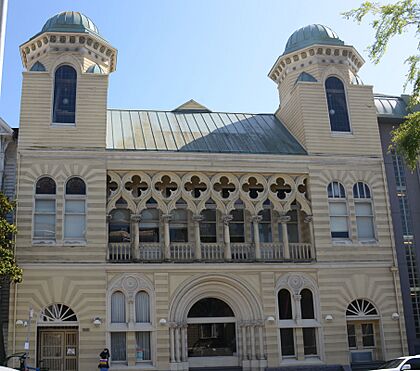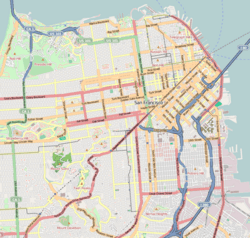Bush Street Temple facts for kids
Quick facts for kids Bush Street Temple |
|
|---|---|

The former synagogue building, in 2019
|
|
| Religion | |
| Affiliation |
|
| Ecclesiastical or organisational status |
|
| Ownership | Japanese American Religious Federation |
| Status |
|
| Location | |
| Location | 1881 Bush Street, San Francisco, California |
| Country | United States |
| Architecture | |
| Architect(s) | Moses J. Lyon |
| Architectural type | Synagogue architecture |
| Architectural style |
|
| Date established | 1864 (as a congregation) |
| Completed | 1895 |
| Materials | Redwood |
The Bush Street Temple is a special building in San Francisco, California. It has been many things over the years. It started as a Jewish place of worship called a synagogue. Later, it became a Buddhist temple. It was even used as a Baptist church for a while.
Since 2003, the building has been a home for older people. It was also used by the San Francisco Go Club for many years. The building was finished in 1895. It became a special San Francisco Landmark on April 18, 1976.
Contents
The Building's Design
The Bush Street Temple was designed by an architect named Moses J. Lyon. It was completed in 1895. The building has a unique look, mixing two styles: Moorish Revival and Venetian Gothic Revival.
Cool Architectural Features
The front of the building has beautiful arches. These arches look like the ones found on the famous Doge's Palace in Venice, Italy. The building was mostly built using redwood wood.
Inside, parts of the building were painted to look like marble. This painting style is called trompe-l'œil, which means "trick the eye." The building used to have two tall, fancy towers, but they are no longer there. In 2003, the old building was updated and connected to a new building next to it.
A Building with Many Lives
The Bush Street Temple has a long and interesting history. It has served different communities and purposes over the years.
Jewish Synagogue: Congregation Ohabai Shalome
The building first opened as a synagogue for a group called Congregation Ohabai Shalome. This name means "Lovers of Peace" in Hebrew. The group started in 1864. They were members who left another synagogue because they wanted to keep older traditions.
People often called it the Bush Street Synagogue. Over time, fewer people joined the congregation. In November 1934, the group sold the building. It was bought by the Soto Zen Mission of the Sokoji Buddhist Church.
Home for the San Francisco Go Club
The San Francisco Go Club is a group that plays the ancient board game Go. In 1936, this club became the first overseas branch of Japan's Nihon Ki-in, a big Go organization. In 1937, the club moved into the left side of the Bush Street building.
The Go club stayed there for a long time. They even remained when other parts of the building were empty. They finally had to move out around 1994 because the building was going to be redeveloped.
Buddhist Temple: Sokoji Soto Zen Mission
After the synagogue, the building became a Buddhist temple for the Sokoji Soto Zen Mission. During World War II, many Japanese-Americans, including the owners and members of this temple, were sent to special camps. This was part of the wartime Japanese American internment.
While they were in the camps, the Japanese-American owners still paid for the building. During this time, a different church, the Macedonia Missionary Baptist Church, used the building. Its members were mostly African-Americans from the southern United States. After the war, the Zen Mission got their building back.
Zen Buddhism in America
In 1959, a special teacher named Shunryu Suzuki Roshi came to Sokoji. He taught a type of meditation called zazen. This was new and exciting for many people in America. Soon, many Western students came to learn from him.
The San Francisco Zen Center was created by Suzuki Roshi's Western students. They shared the building with the Sokoji community through the 1960s. This building became a very important place for spreading Zen Buddhism in the United States. In 1969, the Zen Center needed more space and moved to a different location. The Sokoji community also moved in 1972. After that, the building was empty and started to fall apart. The San Francisco Redevelopment Agency took ownership of it.
New Life for the Building
In the late 1980s, some people tried to turn the building into a Jewish Cultural Center, but it didn't happen. In 1996, the Japanese American Religious Federation took ownership of the building.
Eventually, the building was given to Kokoro Assisted Living. This is a home for senior citizens, many of whom are from the Japanese-American community. Kokoro opened its doors in 2003, giving the historic Bush Street Temple a new purpose.
See also
- Buddhism in the United States
- List of San Francisco Designated Landmarks


